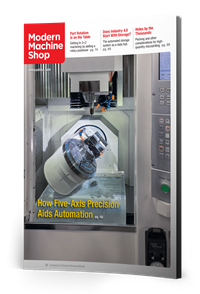Coolant And Center-Drilling Considerations For Machining Small Holes
Through-spindle coolant is good if you can get it, but the spot drilling might not be necessary. Try a pilot hole instead?
Share






A reader recently used the “Ask an Expert” feature of our Micromachining Zone to submit the following question:
Question
We are challenged to drill 0.081-inch +/-0.0006 holes in AISI 321 stainless steel. Depth of the through hole is 0.384 inch. What advice can you offer?
Response from John Bradford, micromachining R&D team leader for Makino
I have some general information to share that will help guide you.
Some guidelines regarding coolant:
Use a water-soluble coolant with a minimum concentration of 8%. Increase concentration as the material gets tougher or harder. At 0.080 inch diameter, it may be very tough to find tooling that provides for through-spindle coolant. The smallest we have seen with through-spindle coolant is 0.080 inch for standard twist drill type tooling. I'm sure there are gun drills out there that have the capability at smaller diameters, but gun drilling is specialized and somewhat slow from a processing standpoint. Overall, for through-spindle coolant, pressure is important—but flow is equally important for drilling since this is the mechanism that keeps the chips moving out of the whole. At some point, due to tool diameter dictating orifice size, pressure is still available but flow is minimal.
Some approaches to center drilling and piloting of holes:
Whenever possible, we try to eliminate spot drilling to avoid the added cycle time and tooling. We have been successful in holding positional tolerance without spot drilling by using tooling with at least 130-degree-included tip angle. 135-degree is the most common tip we use. For deeper holes (over 12:1), we will generate a pilot hole at 0.001" diameter oversize and about 3:1 deep. Then we follow behind the pilot hole with the deep-hole drill. Other variables sometime come into play, but as long as the tool starts with the tool axis normal to the surface, results are good.
Related Content
-
A History of Precision: The Invention and Evolution of Swiss-Style Machining
In the late 1800s, a new technology — Swiss-type machines — emerged to serve Switzerland’s growing watchmaking industry. Today, Swiss-machined parts are ubiquitous, and there’s a good reason for that: No other machining technology can produce tiny, complex components more efficiently or at higher quality.
-
Where Micro-Laser Machining Is the Focus
A company that was once a consulting firm has become a successful micro-laser machine shop producing complex parts and features that most traditional CNC shops cannot machine.














